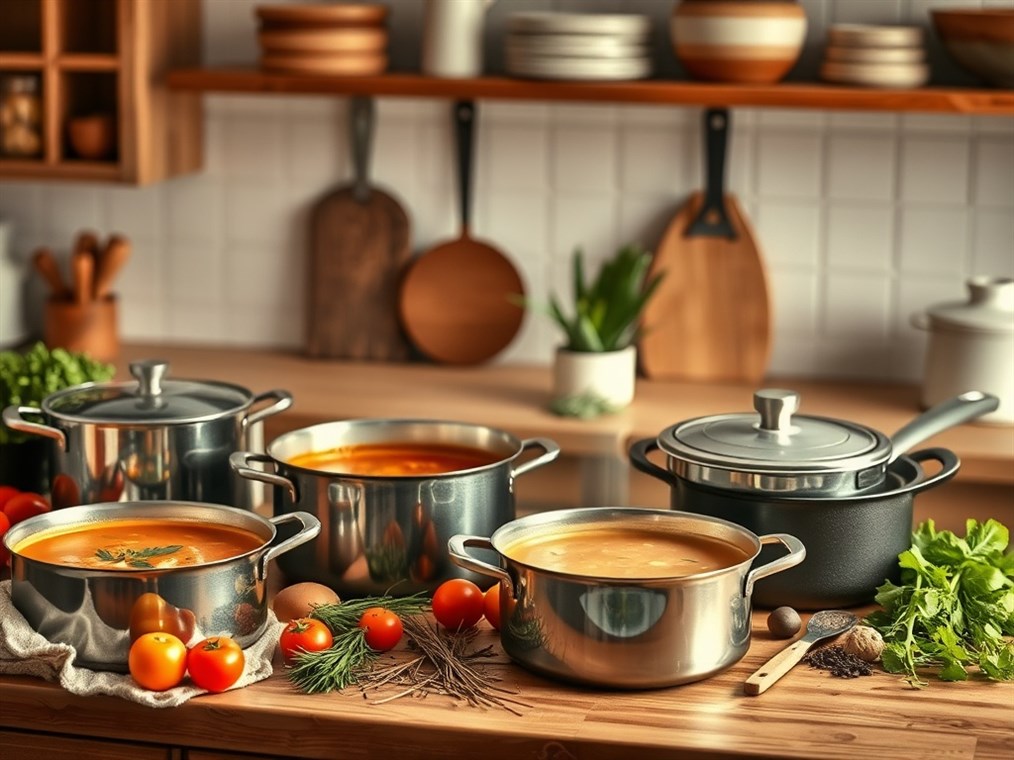Soup’s On! Finding the Perfect Pot for Your Culinary Creations
Let’s face it, soup is a hug in a bowl. It’s comfort food at its finest, and whether you’re whipping up a quick weeknight dinner or simmering a batch of broth for days, the pot you use makes a real difference. But with so many options staring back at you from the store shelves, how do you choose the right one? Don’t worry, I’m here to help you navigate the world of soup pots and find the perfect match for your cooking style.
First things first, let’s clear up some confusion. What’s the deal with stockpots versus soup pots? Are they the same thing? Well, not exactly. Think of it this way: a stockpot is your tall, slender friend, built for the long haul. It’s designed for simmering large quantities of liquid for ages, like when you’re making a big batch of chicken stock. Because of their height, stockpots minimize evaporation, which is essential for long simmering. Soup pots, on the other hand, are a bit shorter and wider, giving you more surface area. This makes them fantastic for browning ingredients – think onions, garlic, and sausage – before you add any liquid. Plus, that wider base helps the soup reduce and concentrate its flavors.
Now, let’s talk materials. This is where things get interesting. The material of your pot seriously impacts how your soup cooks, so it’s worth paying attention to.
Stainless steel is a classic for a reason. It’s tough, easy to clean (hallelujah!), and doesn’t react with acidic foods like tomatoes. But here’s a tip: look for stainless steel pots with an aluminum core or base. Aluminum heats up quickly and evenly, preventing those annoying hot spots that can scorch your soup. “Fully clad” stainless steel, where the aluminum goes all the way up the sides, is even better!
Then there’s enameled cast iron. Oh, how I love my enameled cast iron Dutch oven! These pots are like the superheroes of the kitchen. They hold heat like nobody’s business, distribute it evenly, and look gorgeous doing it. The enamel coating means you don’t have to worry about the cast iron reacting with acidic ingredients, either. They’re perfect for slow-cooking, braising, and making stews that taste like they’ve been simmering all day. The downside? They can be heavy and a bit pricey, but trust me, they’re worth the investment.
Speaking of cast iron, you can also go with bare cast iron. It offers amazing heat retention, but it requires a bit more TLC. You’ll need to season it regularly to prevent rust and sticking, and you might notice it reacting with acidic foods, giving your soup a slightly metallic taste.
Aluminum pots are lightweight and budget-friendly, but they can warp easily and react with acidic ingredients. Anodized aluminum is a better bet. It’s been treated to make it harder, more durable, and non-reactive.
And finally, there’s copper. Copper pots are beautiful and heat up like a dream, giving you incredible temperature control. But they’re also expensive and require a lot of upkeep. Plus, you need to make sure they’re lined with a non-reactive material like stainless steel to prevent any unwanted chemical reactions.
Okay, so you know the materials. What about size and shape? Well, that depends on how much soup you usually make. For small families or solo cooks, a 4-8 quart pot should do the trick. If you’re cooking for a crowd or like to have leftovers, go for a 6-12 quart pot. And if you’re serious about making stock, or you have a large family, consider an 8+ quart pot.
As for shape, remember what we said about stockpots and soup pots. Taller, narrower pots are best for stocks, while shorter, wider pots are great for soups and stews where you want to brown ingredients and concentrate flavors.
Before you click “buy,” here are a few more things to keep in mind:
- Lid: A tight-fitting lid is a must for locking in moisture and flavor.
- Handles: Look for sturdy, comfortable handles that you can grip easily, even with oven mitts.
- Base Thickness: A thick base prevents scorching, especially for soups that simmer for a long time.
- Stovetop Compatibility: Make sure the pot works with your stovetop!
- Ease of Cleaning: Nobody wants to spend hours scrubbing pots and pans. Choose one that’s easy to clean, either by hand or in the dishwasher.
So, what are my top picks?
- Overall Best: Misen 8-Quart Stainless Steel Stockpot
- Best Splurge: All-Clad D3 Stainless Steel 12-Quart Covered Stock Pot
- Best Budget: Cook N Home 8-Quart Stockpot
- Best Enameled Cast Iron: Le Creuset Enameled Cast Iron Round Dutch Oven
Ultimately, the best pot for soup is the one that fits your needs and cooking style. Do your research, consider your options, and get ready to make some seriously delicious soup! Happy cooking!

